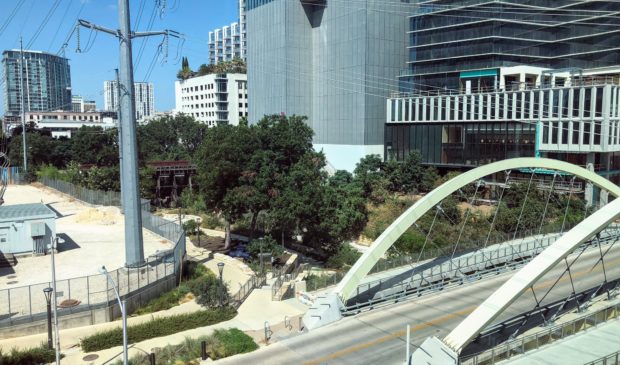Cypress and Shoal Creek Project potential recipient of hotel tax dollars
Friday, January 10, 2020 by
Ryan Thornton The Public Works Department has studied various ways to prioritize and fund the Cypress and Shoal Creek Project on the northeastern edge of the Seaholm District. Now the department has determined that the Historic Preservation portion of the Hotel Occupancy Tax could help get part of it completed.
Public Works Director Richard Mendoza wrote a memo Thursday stating that one part of the project, the renovation of the railroad bridge on Third Street, could be a candidate for the funds.
If that does prove to be an option, Mendoza said the project would need to go through the city’s Heritage Grant Program application process after a thorough interdepartmental review regarding the site’s eligibility criteria.
The memo is a response to an Aug. 8, 2019, City Council resolution asking for an overview of the project as well as the Seaholm Intake Project and ideas for prioritization and funding. Specifically, the resolution asked the city manager to consider whether it would be possible to expand the Seaholm tax increment financing district east to Nueces Street and use those dollars for the bridge, trail and public plazas.
Ted Siff, president of the Shoal Creek Conservancy Board of Directors, argued for that option in August, saying that the project has the potential to attract economic development and unlock more tax revenue for the city.
Public Works, however, disagrees with Siff’s assessment.
“Typically, the creation of a (tax increment reinvestment zone) or amendment to an existing (TIRZ) project plan is for significant infrastructure projects in areas that are under-development or lacking specific development,” Mendoza said. “The Seaholm area is essentially a built-out area, and any one project may not drive additional ‘uplift’ in property values, above and beyond market-driven increases.”
The Seaholm tax increment reinvestment zone was created by Council in 2008 to collect a total of $20.4 million for infrastructure improvements to help the area develop. By the end of Fiscal Year 2020, the city will have collected approximately $17.7 million of that sum and all of the revenue required to fund the district’s projects by the end of Fiscal Year 2022. Once the projects are paid for, Public Works expects that the tax increment financing district will be dissolved and any remaining funds and future revenue would be directed to the city’s General Fund.
In August, Mayor Steve Adler and Council Member Jimmy Flannigan both expressed discomfort with using the financing district to prioritize the project in a move that would potentially subvert the city’s typical prioritization process.
The Shoal Creek Conservancy, however, says the project is worth prioritizing. The conservancy’s website says the intersection of Shoal Creek and Third Street, where the bike and pedestrian bridge runs parallel to the trestle bridge, will soon be the “main at main” for pedestrian activity downtown, noting its proximity to new high-density residential development and the Central Library.
Nonetheless, Public Works said that doesn’t make the project eligible for tax increment financing. Mendoza noted that the blocks to the east of the financing district, where Council proposed its expansion, are not only already built out, but are part of the Green Water Treatment Plant redevelopment that directs all of its property tax revenue into the city’s housing trust fund.
Two other funding options – existing public bonds and Parkland Dedication funds – were likewise deemed nonviable due to financial commitments to other high-priority projects.
If the city decides to pursue Hotel Occupancy Tax revenue for the project, Mendoza said it will be evaluated based on historic designation, shovel-readiness, tourism impact, assigned priority, geographical equity, cost and availability of private funding, and other measurable criteria.
In the meantime, the Shoal Creek Conservancy will soon select a consultant to develop the Cypress and Shoal Creek Project concept and aims to have a complete plan this summer. As of now, the total cost of the project is estimated at around $18 million.
Photo by Ryan Thornton.
The Austin Monitor’s work is made possible by donations from the community. Though our reporting covers donors from time to time, we are careful to keep business and editorial efforts separate while maintaining transparency. A complete list of donors is available here, and our code of ethics is explained here.
You're a community leader
And we’re honored you look to us for serious, in-depth news. You know a strong community needs local and dedicated watchdog reporting. We’re here for you and that won’t change. Now will you take the powerful next step and support our nonprofit news organization?







